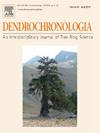阿尔及利亚阿特拉斯开心果种群的生长速率及其对气候和干旱的响应
IF 2.7
3区 农林科学
Q1 FORESTRY
引用次数: 0
摘要
阿特拉斯开心果(阿特拉斯开心果)是一种小型硬木物种,由于在马格里布的一些地区过度开发而受到威胁,但它显示出非凡的生态可塑性,居住在从地中海潮湿到干旱的条件下。为了评估这一未被充分研究的物种的耐旱性,我们沿着干旱增加的N-S梯度取样了三个阿尔及利亚种群:Theniet el Had(半湿润地点,H), Djelba(半干旱或干燥地点,D)和b本文章由计算机程序翻译,如有差异,请以英文原文为准。
Growth rates and responses to climate and aridity of Algerian Atlas pistachio populations
The Atlas pistachio (Pistacia atlantica) is a minor hardwood species threatened due to overexploitation in some regions of the Maghreb, but it shows an extraordinary ecological plasticity inhabiting sites subjected from Mediterranean humid to arid conditions. To assess the drought tolerance of this understudied species, we sampled three Algerian populations along a N-S gradient of increasing aridity: Theniet el Had (sub-humid site, H), Djelba (semi-arid or dry site, D) and Béchar (arid site, A). First, ring-width chronologies were built. Second, correlations between ring-width indices, climate variables, a drought index and teleconnection indices (NAO, North Atlantic Oscillation; MOI, Mediterranean Oscillation index; SOI, Southern Oscillation Index; SaOI, Sahara Oscillation Index) were calculated. A high precipitation in the previous autumn and winter enhanced radial growth of Atlas pistachio and also high June precipitation in the wettest site H. In the driest site A, high maximum temperatures in spring constrained growth. High minimum temperatures in late summer and early autumn enhanced growth in sites D and A, which showed similar year-to-year growth variability (r = 0.426, p = 0.015, period 1980–2011). Correlations with a drought index peaked in the driest site A from September to December. Positive relationships between growth and drought indices in spring and autumn suggest a bimodal growth pattern. The three sites showed positive correlations between growth indices and the April MOI. However, negative relationships were found for January NAO or MOI and spring indices (June NAO, May SOI) in site H. Here, growth rates were negatively related to the SaOI. The Atlas pistachio shows a remarkable drought tolerance and its climate-growth relationships indicate plastic growth responses to precipitation variability.
求助全文
通过发布文献求助,成功后即可免费获取论文全文。
去求助
来源期刊

Dendrochronologia
FORESTRY-GEOGRAPHY, PHYSICAL
CiteScore
5.50
自引率
13.30%
发文量
82
审稿时长
22.8 weeks
期刊介绍:
Dendrochronologia is a peer-reviewed international scholarly journal that presents high-quality research related to growth rings of woody plants, i.e., trees and shrubs, and the application of tree-ring studies.
The areas covered by the journal include, but are not limited to:
Archaeology
Botany
Climatology
Ecology
Forestry
Geology
Hydrology
Original research articles, reviews, communications, technical notes and personal notes are considered for publication.
 求助内容:
求助内容: 应助结果提醒方式:
应助结果提醒方式:


